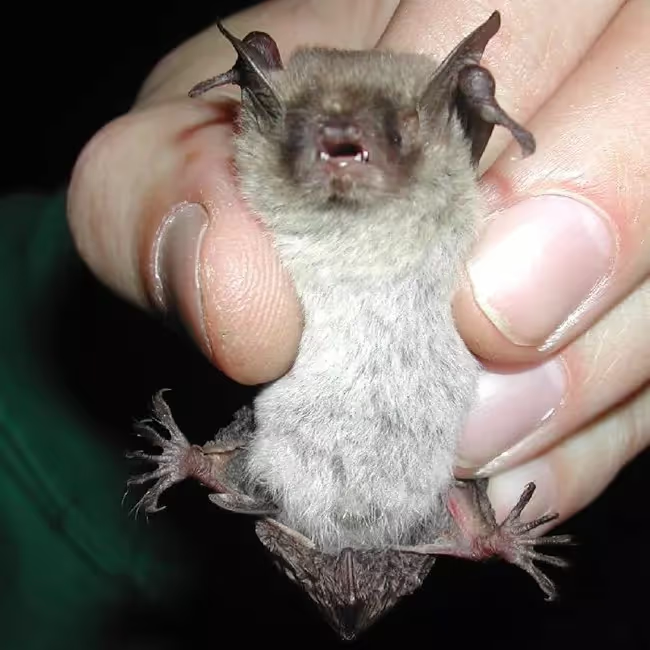Yuma Myotis


Washington Coast is home to many species of bats, the Olympic National Park alone being home to nine species (NPS 2020). One of the more common bats is the Yuma myotis (Myotis yumanensis).
Myotis, or mouse-eared bats, are a genus of vesper bats (Vespertilionidae). Yuma myotis get their name from Fort Yuma, a former fort near Yuma, Arizona, where the species was first documented. They range from British Columbia to central Mexico and as far east as western Texas. A 2014 study of myotis specimens in the University of Alaska Museum’s collection showed that the species, as of the early 1990s, did have a presence in southeastern Alaska and may still today (Olson et al 2014).
There are six subspecies of Yuma myotis, two of which are found in Washington State. M. y. saturatus can be found in British Columbia, western Washington, western Oregon, and California while M. y. sociabilis can be found in eastern Washington, eastern Oregon, Idaho, western Montana, and north-eastern California.
As a species, Yuma myotis have a wide variety of appearances across their range. Fur color can range from gray to dark brown to pale tan. M. y. saturatus is described as having dark brown to chestnut colored fur with dark ears and eyes and pale underparts (WDFW n.d.). They are fairly small for myotis, with a head-body length of 1.5-1.9 inches (3.9 to 48. cm) and an average wingspan of 9.4 inches (24 cm). They have a large, unkeeled calcar, a spur of cartilage running along their interfemoral membrane (located between their tails and hind legs) which helps them spread the membrane.
They share many physical similarities with the little brown myotis (Myotis lucifugus) and it can be difficult to tell the two species of bats apart just by looking at them. Identification is often done using physical characteristics in combination with other factors, such as DNA and echolocation calls.
Yuma myotis are found in a wide variety of habitats, including riparian areas, forests, grasslands, shrubsteppe, and deserts. They are almost always found near water as they feed over water sources.
Yuma myotis eat a wide variety of insects, including beetles, flies, termites, moths, and mayflies (Solari 2018). They start feeding at dusk and finish about two hours after sunset, after which they gather in an area to roost. Many places can be used as roosting spots, including caves, mines, abandoned buildings, the undersides of bridges, and more.
Mating occurs during the fall, with both males and females mating with multiple partners, but fertilization does not occur until the spring. In Washington, birth usually occurs in June (WDFW n.d.). Females and their offspring will roost in maternity colonies between the months of April and October. Maternity colonies can contain thousands of bats and often include bats from other species, such as little brown myotis. The largest maternity colony in Washington is located at Hanford and contains 4,100 adults (WDFW n.d.). Yuma myotis have one pup a year.
Yuma myotis is one of the bat species affected by white-nose syndrome. The first Yuma myotis confirmed to have the illness was found in North Bend, Washington in 2017 (Froschauer 2017).
References
Froschauer, A. (2017, May 11). Researchers Work to Stop the Spread of White-nose Syndrome in Washington. White Nose Syndrome. https://www.whitenosesyndrome.org/blog/researchers-work-to-stop-the-spread-of-white-nose-syndrome-in-washington-4
National Parks Service. (2020, September 22). Terrestrial Mammal Species list. https://www.nps.gov/olym/learn/nature/mammal-species-list.htm
Olson, L. E., Gunderson, A. M., MacDonald, S. O., & Blejwas, K. M. (2014). First Records of Yuma Myotis (Myotis yumanensis) in Alaska. Northwestern Naturalist, 95(3), 228–235. https://doi.org/10.1898/13-29.1
Sims, K. (n.d.). Myotis yumanensis (Yuma myotis). Animal Diversity Web. https://animaldiversity.org/accounts/Myotis_yumanensis
Solari , S. (2018, June 27). Yuma Myotis. IUCN Red List of Threatened Species. https://www.iucnredlist.org/species/14213/22068335
Washington Department of Fish & Wildlife. (n.d.). Yuma Myotis (Bat). https://wdfw.wa.gov/species-habitats/species/myotis-yumanensis
© Laura Caldwell, November 2023
Touch whale bones, examine shipwreck artifacts and connect with the coast's living history.

Support our mission, get involved in educational programs, or contribute through donations and volunteering.